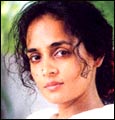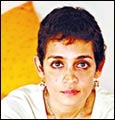Woman of the month |
|
|
Baby Care |
|
|
Beauty Tips |
|
|
Household Tips |
|
|
Recipes |
|
|
Mehendi |
|
|
|
Suzanna Arundhati Roy |

|
Suzanna Arundhati Roy was born on the 24th
November 1961, the child of a marriage between a Christian woman from Kerala and a Bengali
Hindu tea planter.
Arundhati spent her crucial childhood years in Aymanam. There, her mother Mary Roy (later
a well-known social activist) ran an informal school named Corpus Christi where Arundhati
developed her literary and intellectual abilities unconstrained by the set rules of formal
education. Aymanam is no longer the old-fashioned village of the sixties in which the
novel is set. It is |
|
now a bustling extension of Kottayam town, with 7,000 houses and a rash of
dish antennae. Paradise Pickles still exists. Social prejudices have dissolved to great
extent, though an affair between a low caste man and an upper caste woman can still cause
quite a flutter.
She says that she was never "part of this safe world where you grow up and then are
married and |
sent off. You know it's actually terrifying
for people and in many ways I escaped that. Having an arranged life and being sent off to
some stranger's house. But on the other hand escaping that meant watching it from the
outside and not knowing exactly what would happen to you."
Arundhati Roy left home at 16 and then lived in a squatters' camp, in a small hut with a
tin roof, within the walls of Delhi's Ferozshah Kotla. She made a living selling empty
beer bottles. It was six years before she saw her mother again. |

|
|
Eventually, Roy joined the Delhi School of Architecture, moonlighting as an architect's
artist. She married a fellow architecture student, Gerard Da Cunha. Their marriage lasted
four years. At this stage, neither had a great love for architecture and so they quit.
Arundhati Roy has been described as: charming, humorous, strong-willed, independent,
energetic, |

|
creative, with a great sense of fun, 1.55m
of doe-eyed delicateness, a down-to-earth 'girl next door', a towering intellect with a
poetic fluency with words delivered in a soft modulated voice, a dog-lover.
She is 40 years old and describes her two favourite pastimes as 'writing and running'.
The Prize:
Arundhati Roy's debut novel The God of Small Things was launched on 4 |
|
April 1997 in Delhi and won the Booker prize
in London, on 14 October 1997. In the intervening period, she received a reported
?500,000 in advances and the rights to her book were sold in 21 countries.
However, the success of The God of Small Things has not been entirely unquestioned.
|
Archive |
|